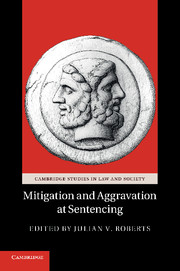Book contents
- Frontmatter
- Contents
- Tables
- Contributors
- Foreword
- Acknowledgments
- Chapter one Punishing, more or less
- Chapter two Re-Evaluating the Justifications for Aggravation and Mitigation at Sentencing
- Chapter three The Search for Principles of Mitigation
- Chapter Four Personal Mitigation and Assumptions about Offending and Desistance
- Chapter Five Intoxication as a sentencing factor
- Chapter Six Beyond the Partial Excuse
- Chapter Seven Equality before the law
- Chapter Eight Personal mitigation
- Chapter Nine Exploring Public Attitudes to Sentencing Factors in England and Wales
- Chapter Ten The Pernicious Impact of Perceived Public Opinion on Sentencing
- Chapter Eleven Addressing Problematic Sentencing Factors in the Development of Guidelines
- Chapter Twelve Proof of Aggravating and Mitigating Facts at Sentencing
- Chapter Thirteen Mitigation in Federal Sentencing in the United States
- Chapter Fourteen The discretionary effect of mitigating and aggravating factors
- Index
- References
Chapter Thirteen - Mitigation in Federal Sentencing in the United States
Published online by Cambridge University Press: 07 September 2011
- Frontmatter
- Contents
- Tables
- Contributors
- Foreword
- Acknowledgments
- Chapter one Punishing, more or less
- Chapter two Re-Evaluating the Justifications for Aggravation and Mitigation at Sentencing
- Chapter three The Search for Principles of Mitigation
- Chapter Four Personal Mitigation and Assumptions about Offending and Desistance
- Chapter Five Intoxication as a sentencing factor
- Chapter Six Beyond the Partial Excuse
- Chapter Seven Equality before the law
- Chapter Eight Personal mitigation
- Chapter Nine Exploring Public Attitudes to Sentencing Factors in England and Wales
- Chapter Ten The Pernicious Impact of Perceived Public Opinion on Sentencing
- Chapter Eleven Addressing Problematic Sentencing Factors in the Development of Guidelines
- Chapter Twelve Proof of Aggravating and Mitigating Facts at Sentencing
- Chapter Thirteen Mitigation in Federal Sentencing in the United States
- Chapter Fourteen The discretionary effect of mitigating and aggravating factors
- Index
- References
Summary
Other chapters in the present volume explore sentencing factors in jurisdictions such as South Africa, Canada or New Zealand, where courts impose sentence in the absence of formal guidelines. Across the United States, however, many jurisdictions employ formal sentencing guidelines, often in the form of a two-dimensional sentencing grid. These guidelines establish a ‘presumptive’ range of sentence for all offences. One of the most well-known and often studied systems is found at the federal level and applies to all offenders sentenced in the federal courts. The US Sentencing Commission issues these guidelines. The federal guidelines employ a two-dimensional grid (offence seriousness; criminal history) with 256 cells that delineates six-month sentencing ranges.
Since their adoption in 1987, the US federal sentencing guidelines have required the use of narrow mandatory sentencing ranges in almost every case, thereby contributing to the creation of one of the largest prison populations in the world (Luna 2005; Stuntz 2001). In determining ranges the mandatory sentencing guidelines identified which aggravating factors must be considered while severely restricting the consideration of mitigating factors at sentencing, disfavouring most potential mitigating factors (Tonry 1996).
- Type
- Chapter
- Information
- Mitigation and Aggravation at Sentencing , pp. 247 - 260Publisher: Cambridge University PressPrint publication year: 2011
References
- 1
- Cited by

